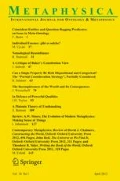Abstract
I discuss E. J. Lowe’s conception of criteria of identity and sketch a different and, I think, more adequate conception. On my view, criteria of identity are some of the things we can do. They are what we do when distinguishing between single entities of the kind in question and pairs of entities of the relevant domain. And they enable us to make such distinctions because they are applicable to all single and to all pairs of entities of the relevant domain but fulfilled only by all single entities of the kind in question. This feature of criteria of identity allows us to define these criteria, to explain how to identify a particular criterion of identity and to determine the logical form in which to express such identifications.
Similar content being viewed by others
Notes
Cf. Lowe 2007, p. 521.
See Lowe 2003, p. 75.
Cf. Lowe’s distinction between metaphysical principles of individuation and criteria of identity in Lowe 2007, p. 522.
See Lowe 1989a, p. 13.
See ibid., p. 5f.
See ibid., p. 19. For Lowe’s view on criteria of identity and sortal terms, see also Lowe 1989b, particularly chapter 2.
See Lowe 1989a, p. 6.
Lowe distinguishes between what he calls type A and type B criteria of identity and attributes different logical forms to those criteria. See ibid., p. 3. and p. 6. For further discussion on the distinction between type A and type B criteria of identity, see also Lowe 1991 and 1999 and Williamson 1990 and 1991.
See Lowe 1989a, p. 8.
See Davidson 1969.
See Lowe 1989a, p. 8f.
See ibid., p. 12f.
Cf. Lowe 2007, p. 515.
Some philosophers prefer to speak merely of the pair of entities (x, y) because they assume that a pair may consist of a single entity and that entity itself. But since I consider any pair of entities to consist of exactly two entities, I prefer to use instead of the phrase “the pair of entities (x, y)” the phrase “the entity (x, y) or the pair of entities (x, y)”. And I thereby assume that the variables “x” and “y” may have the same entity as their value.
See Kellenberg 2007, pp. 228–30.
I discuss this definition of criteria and I give a detailed analysis of applicability and fulfillment in op. cit., pp. 120–3 and pp. 126–55. In that work, I discuss also at greater length my conception of criteria and of criteria of identity as well as the distinction between individuation and identification. See especially chapters IV, V, and VII.
I deal with this question in detail in op. cit.
In my opinion, the ordinary language expression “… is the same apple as ---” is ambiguous in at least two respects. It may be understood either in the sense of “the entity (…,---) fulfills the criterion of identity for apples” (which, according to what I have said above, means “… is an apple and --- is an apple and … is the same object as ---”) or in the sense of “… is an apple and --- is an apple and … is qualitatively indistinguishable from ---”. This is important because, according to my conception of objects (developed in op. cit.), sentences such as “The apple on the table is the same apple as the apple on the table” are true in either sense of “same apple”, whereas sentences such as “The apple on the table is the same apple as the apple in the room” are true at most in the second sense of “same apple”.
A complex predicate is, according to my usage of this term, a predicate conveying information required for the identification of the corresponding criterion. For example, the predicate “male sibling” is a complex predicate denoting the criterion for male siblings. It conveys the information that the criterion denoted by that predicate consists of the criterion for males and of the criterion for siblings.
See Lowe 1989b, p. 22ff.
References
Davidson, D., (1969) “The Individuation of Events”, in: Rescher, N. (ed.), Essays in Honor of Carl G. Hempel, pp. 216–234. Dordrecht: Reidel. Repr. in: Davidson, D., Essays on Actions and Events, pp. 163–180. Oxford: Clarendon, 2001.
Geach, P. T., (1962) Reference and Generality. Ithaca: Cornell University Press.
Geach, P. T., (1972) Logic Matters. Oxford: Blackwell.
Hawthorne, J., (2003) “Identity”, in: Loux, M./ Zimmerman, D. (eds.), The Oxford Handbook of Metaphysics, pp. 99–130. Oxford: Oxford University Press.
Kellenberg, A., (2007) Metaphysische Untersuchungen—Erster Teil. Frankfurt: Ontos.
Lowe, E. J., (1989a) “What is a Criterion of Identity?”, The Philosophical Quarterly 39, pp. 1–21.
Lowe, E. J., (1989b) Kinds of Being, A Study of Individuation, Identity and the Logic of Sortal Terms. Oxford: Blackwell.
Lowe, E. J., (1989c) “Impredicative Identity Criteria and Davidson’s Criterion of Event Identity”, Analysis 49, pp. 178–181.
Lowe, E. J., (1991) “One-level versus two-level Identity-Criteria”, Analysis 51, pp. 192–194.
Lowe, E. J., (1999) “Objects and Criteria of Identity”, in: Hale, B./ Wright, C. (eds.), A Companion to the Philosophy of Language, pp. 613–633. Oxford: Blackwell.
Lowe, E. J., (2003) “Individuation”, in: Loux, M./ Zimmerman, D. (eds.), The Oxford Handbook of Metaphysics, pp. 75–95. Oxford: Oxford University Press.
Lowe, E. J., (2007) “Sortals and the Individuation of Objects”, Mind & Language 22, pp. 514–533.
Noonan, H., (1997) “Relative Identity”, in Hale, B./ Wright, C. (eds.), A Companion to the Philosophy of Language, pp. 634–652. Oxford: Blackwell.
Wiggins, D., (2001) Sameness and Substance Renewed. Cambridge: Cambridge University Press.
Williamson, T., (1990) Identity and Discrimination. Oxford: Blackwell.
Williamson, T., (1991) “Fregean Directions”, Analysis 51, pp. 194–195.
Author information
Authors and Affiliations
Corresponding author
About this article
Cite this article
Kellenberg, A. Identifying Criteria of Identity. Int Ontology Metaphysics 10, 109–122 (2009). https://doi.org/10.1007/s12133-009-0043-5
Received:
Revised:
Accepted:
Published:
Issue Date:
DOI: https://doi.org/10.1007/s12133-009-0043-5


